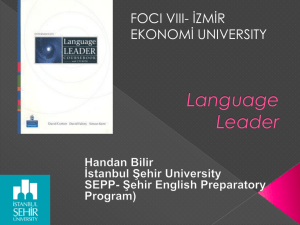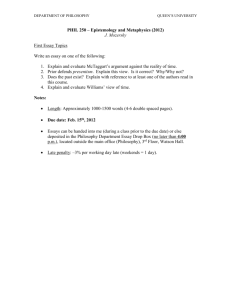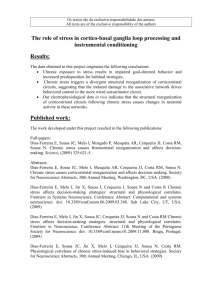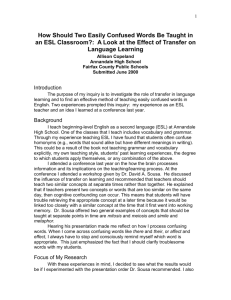File
advertisement
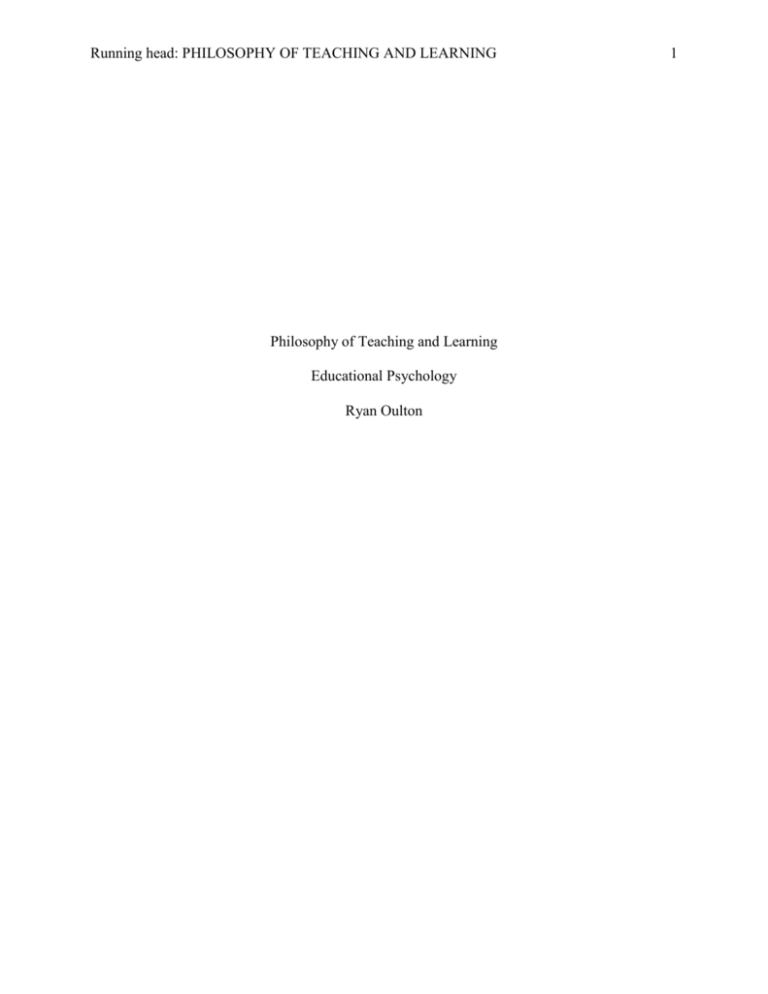
Running head: PHILOSOPHY OF TEACHING AND LEARNING Philosophy of Teaching and Learning Educational Psychology Ryan Oulton 1 PHILOSOPHY OF TEACHING AND LEARNING 2 As a teacher, I believe it is important to continually seek further education into best practices in teaching and keep up to date on the current understanding of how the brain processes learning. I am a strong believer in establishing a safe, constructive learning environment that focuses on student-centered learning and social interaction. I believe that my students should be treated fairly and given every opportunity to have positive learning experiences. In an effort to motivate the 21st Century Learners, as well as cater to various learning styles, I will use technology in the classroom for purposeful and authentic learning. Additionally, I feel that a combination of popular culture implementation and effective discourse strategies will motivate my students to want to learn and explore in my classroom. By incorporating universal design for learning and understanding how each unique student in my classroom learns, I will ensure my students succeed. One of the most effective things I can do as a teacher is design a safe classroom environment that encourages student-centered learning. The classroom will focus on facilitating peer-peer interactions and feature less of a division between me and the students. I will hold judgement on responses and solutions offered by students in an effort to encourage involvement and participation by all. Organizing the desks in pairs, featuring my desk at the back of the room, will promote student collaboration during the learning process. Rather than students needing me to pass knowledge to them, they will come to realize that, through discussion with their peers, they have the tools to discover knowledge themselves (Bruner, 1996). In my science classroom, students will take on more of the responsibility for learning; I will simply act as a facilitator to discussion by questioning their thought process, modeling effective practices and providing the necessary resources for building knowledge. I will develop my students’ talents, skills and abilities in the math classroom by offering practice of material, in combination with conceptual explanation. These teaching practices will foster linguistic, spatial, numerical, and interpersonal skills within my classroom, ultimately producing authentic student learning. Social-interaction between students of differing developmental levels is important in the learning process. Not only is peer-peer conversation great for self-discovery, as mentioned above, but also for assisting the students whom are at varying levels in their learning. I believe in Vygotsky’s theory, in which students have two different levels of development: a level at which they can individually solve problems and a level at which they can complete problems under guidance and collaboration with adults or more capable peers, is useful for my teaching applications (1978). Modelling my practice after this theory, I will group students such that different developmental levels are represented, ensuring that more capable students can assist their peers in increasing individual understanding. To further foster their learning, I will employ scaffolding techniques. I will begin by giving students the necessary information and resources to learn. While students are engaged in the learning process, I will continue to give one-on-one prompts, reminders and encouragement. Eventually I will be able to wean out these reminders and prompts and the students will be at a level where they have successfully demonstrated learning on their own. While a significant amount of building understanding will be done during school hours, I will encourage parents to partake in scaffolding at home by asking their children to explain what they are doing, as well as celebrating their child’s accomplishments. By using myself, parents, and peers as resources in the effort to learn, I will give my students the best chance of success in learning process. I will create a classroom environment in which gender and social class are not defining features in a student’s ability to learn. Social class and gender-bias are ongoing issues, especially in science and math classrooms (Fasado, Jakobsen & Wylie, 2007). To remain gender-neutral, I PHILOSOPHY OF TEACHING AND LEARNING 3 will feature female role models just as much as male role models in the classroom. There are a number of female math and science historic figures, such as: Rosalind Franklin, Marie Curie, Emma Noether, and Hypatia, whose contributions were just as significant as many male mathematicians and scientists. I will encourage answers from female students rather than allow male students to dominate class conversation. Making these efforts will empower my female students and give them motivation to learn (Levi, 2000). To accommodate various social classes within my classroom, I will plan class-time for project research and development, as well as make myself available for extra-help at lunch and after school to make certain all students have the opportunity to ask for adult-help on assignments and homework. This will make sure that even if their parents are not available to help students at home, or the conditions are less than favourable for completing work, that the student’s learning will not be impeded. Furthermore, I will not require elaborate materials that must be specially purchased for projects; students will be given the choice to complete technology-based presentations rather than a presentation needing purchased materials. By treating each student fairly, not dependent on their gender or social class, I will give every one of my students the same opportunity to learn. The emotional well-being of my students will be critical to the learning process. Students’ brains are not fully developed and thus emotion can actually hijack decision making and student behaviour (Faeth & Immordino-Yang, 2010). Keeping this in mind, I will use fun warm-up activities like rebus puzzles and ken-kens in my classroom. These activities will serve to both stimulate thinking and improve emotional levels within my students. Since emotion is most effective at facilitating the development of knowledge when it is relevant to the task at hand, I need to ensure my students are associating positive emotions with my activities; therefore, they need to be engaging, thought-provoking, and fun. It is important that my students have positive experiences in my math and science classrooms so that they do not develop anxieties associated with either subject. When students have negative experiences in a classroom, because emotional responses fuel future behaviour, they will begin to think negatively about everything associated with the subject (Faeth et al, 2010). A negative association with a subject will remove the motivation to learn and thus affect student achievement. By getting to know my students’ interests I can ensure the content material is personable and thus they will be more comfortable in my classroom. By collaborating with my colleagues, I will be able to employ the most appropriate academic interventions for my students. I want not only my own students to succeed in the classroom, but all students in the school as well; by involving my colleagues in the intervention process, I ensure that many perspectives are incorporated into action plans for the success in all students’ learning. Since number sense in Mathematics relies heavily on language skills, it would only make sense for me to seek help from my colleagues who are more versed in English discourse (Dehaene, 2010). Additionally, a number of features in science and math classrooms rely on the ability to read and write, for instance: word problems, literature reading, and lab report writing; therefore, I need to be able to distinguish between a student who is having difficulty with the content and a student who is having difficulty with reading and writing, impeding their ability to learn the material. Recognizing warning signs, as well as consulting with Methods and Resources teachers for help, will make certain my students do not have any obstacles to learning. The implementation of popular culture within my classroom will enhance my students’ learning experience. The 21st Century student is immersed in technology and the media’s PHILOSOPHY OF TEACHING AND LEARNING 4 influence every day. It only makes sense to take advantage of their interest in popular music, movies, social media and hot topic issues to make learning relevant and captivating, as suggested by Henry Giroux and Roger Simon (1988). By universally designing projects and assignments to satisfy not only curriculum outcomes, but pop culture references as well, I essentially offer students the chance to learn while being engaged and expressing creativity. Using popular culture to foster creativity will ensure that my students are building new connections to material, thinking on a higher-order level, and not simply absorbing and regurgitating content. Rather than promoting the memorization of facts, I will encourage more meaningful, divergent thinking (Hardiman, 2010). For example, a science project might consist of having my students bust a myth from MythBusters or Top Gear–popular television shows–and present their scientific evidence in a creative manner to the class. Combining popular culture with the expression of creativity will build meaningful learning for my students. In order to create opportunities for authentic, purposeful learning, I will make full use of the technology available to my students. As evidenced by Chris Dede, robbing a student of all means of technology within the classroom comes as such a shock to their system that it negatively affects learning (2011). I am not suggesting letting students use technology just to fulfill their daily desire, but rather as a means of authentic learning. There are a number of math and science manipulatives and simulations designed for students to help them develop an understanding of difficult concepts, as well as build basic number sense and spatial reasoning skills. I believe by using simulations, I will be able to reach kinaesthetic, visual, and auditory learners (Devlin, 2010). Additionally, having students create PowerPoints, Prezis, or other visual presentations in class-time will increase both their technical skills and content knowledge in a more captivating way; exclusively requiring the use of technology in classroom time will be mindful of my students who do not have access to computers at home. Using technology for learning will benefit my students as long as I am clear in the expectations of its use and never use it for the sake of using it. Although technology use can be a powerful motivator, so too can effective discourse strategies that encourage intrinsic motivation over rewards. Alfie Kohn believes, and has research to support, that any form of reward in the classroom, other than verbal reward, is just as damaging to learning as punishments (Kohn, 1993). Rewards are too distracting for students and they often lose focus on learning. Instead of offering physical rewards, I feel that unexpected, after the fact rewards or words of encouragement on achievement are a better means of motivating students. I also think Jennifer Schmidt and Lee Shumow’s suggestions on effective teaching strategies to motivate science students are of particular interest to me (2014). Following their advice, I will have my students create learning goals with expectations and intended actions to reach their goals. Every time a student reaches their goals, they will feel good about themselves, and thus it will increase their motivation to learn. It is also important that I instil confidence in my students. Students’ self belief in their abilities can sometimes be rather low. By boosting their confidence with simple words of encouragement during the learning process and celebrating accomplishments–big or small–I can really motivate students to succeed in learning. Finally, I would make sure to include current, relevant material in my lessons in order to foster interest. For example, I might incorporate the Mars One project in my science lesson on space, or analyze realistic NHL player salaries when discussing central tendency. By using effective teaching, I will motivate my students and give them reasons to want to explore and learn each and every day. PHILOSOPHY OF TEACHING AND LEARNING 5 Incorporating universal design for learning in my lesson plans, in order to cater to a number of learning styles, will give all students the opportunity to be successful in my classroom. Getting to know my students and how they learn best will be high in priority. Once I have an understanding of the various learning styles and learning difficulties, like: dyscalculia, dyslexia, and other exceptionalities, I can structure my lesson plans with multiple components. For example, given a science class featuring kinaesthetic, visual, and auditory learners, as well as a student with dyslexia, I would design a lesson on the cardiovascular system to include a small PowerPoint lecture, a video representation, as well as a class-wide kinaesthetic simulation. The PowerPoint presentation would be designed with dyslexia friendly font, off-white and grey background and text, and clear separation of ideas on slides, as suggested by Christodoulou et al. (2010). The video would give a visual representation of how the different parts of the heart work together with veins and arteries to supply oxygen to the cells in the body. The class would then take on the roles of different parts of the cardiovascular system, such as: atriums, ventricles, veins, valves, blood cells, oxygen and carbon-dioxide molecules, and the lungs; the students would then be expected to discuss and model a working system. Students would then be given time to discuss with their peers to help each other with any gaps in learning. Offering many different types of activities, rather than strict lecturing, will ensure that all students’ learning styles are met and everyone is given the opportunity to participate. Although I feel I have a good understanding of ways to promote learning in my classroom, I will always have an open mind to new and more effective teaching practices. Not much is known about how students learn, but what is known is the importance of emotion, creativity, and early intervention in learning. Every student has the ability to learn, they just need to be motivated and given the necessary resources and encouragement to flourish. Though sometimes technology can be seen as a distracter, when properly utilized in the classroom, it can be an effective tool in increasing interest and fostering genuine learning. No two students are alike; therefore my teaching practice will need to include activities that reach every learning style. In my experience, when a teacher has as much passion and concern for student achievement as I do, students cannot help but be engaged and focussed on learning. PHILOSOPHY OF TEACHING AND LEARNING Work Cited Bruner, J. (1996). The culture of education. Cambridge, MA: Harvard University Press. Christodoulou, J. A., Eddy, M. D., Gabrieli, J. & O’Loughlin, T. (2010). The reading brain. In Sousa, D. A. (Ed.), Mind, brain, and education: Neuroscience implications for the classroom (pp. 110-136). Bloomington, IN: Solution Tree Press. Dede, C. (2011). Reconceptualising Technology Integration to Meet the Necessity of Transformation. Journal of Curriculum and Instruction, 5 (1), 4-16. doi:10.3776/joci.2011.v5n1p4-16 Dehaene, S. (2010). The calculating brain. In Sousa, D. A. (Ed.), Mind, brain, and education: Neuroscience implications for the classroom (pp. 178-198). Bloomington, IN: Solution Tree Press. Devlin, K. (2010). The mathematical brain. In Sousa, D. A. (Ed.), Mind, brain, and education: Neuroscience implications for the classroom (pp. 163-177). Bloomington, IN: Solution Tree Press. Faeth, M. & Immordino-Yang, M. H. (2010). The role of emotion and skilled intuition in learning. In Sousa, D. A. (Ed.), Mind, brain, and education: Neuroscience implications for the classroom (pp. 68-83). Bloomington, IN: Solution Tree Press. 6 PHILOSOPHY OF TEACHING AND LEARNING 7 Fasado, G. Jakobsen, J. R. & Wylie, A. (2007). Women, work, and the academy: Strategies for responding to ‘post-civil rights era’ gender discrimination. Bernard Center for Research on Women, 2, 1-20. Retrieved from http://bcrw.barnard.edu/wp-content/nfs/reports/NFS2 -Women_Work_and_the_Academy.pdf Giroux, H. & Simon, R. (1988). Schooling, Popular Culture, and a Pedagogy of Possibility. Journal of Education, 170 (1), 9-26. Retrieved from www.iresist.org/media/pdf_files/giro ux.pdf Hardiman, M. M. (2010). The creative artistic brain. In Sousa, D. A. (Ed.), Mind, brain, and education: Neuroscience implications for the classroom (pp. 226-247). Bloomington, IN: Solution Tree Press. Kohn, A. (1993). Punished by rewards. New York, NY: Houghton Mifflin Company Levi, L. (2000). Gender Equity in Mathematics Education. Teaching Children Mathematics, 7(2), 101-105. doi: 10.2307/41199419 Schmidt, J.A., Shumow, L. (2014). Enhancing adolescents’ motivation for science: Researchbased strategies for teaching male and female students. Thousand Oaks, CA: Corwin, a SAGE Company. PHILOSOPHY OF TEACHING AND LEARNING Vygotsky, L. (1978). Mind in society: The development of higher psychological processes. Cambridge, MA: Harvard University Press. 8


